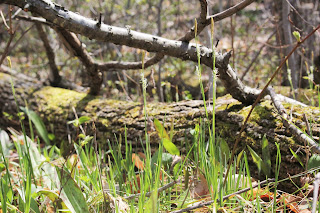On Tuesday I went up for a hike on the Ausable River Valley Trail near Sylvan, off Elm Tree Drive. This trail takes you into some of the best Carolinian habitat that Middlesex has to offer. It is still rather early for most of the notable stuff, but I wanted to take advantage of the good weather.
On my way in, I made a quick stop and checked in on the nesting Common Ravens. Both were present at the nest site. They also nested here last year, which I believe was the first nesting record for Middlesex County.
After I parked the car, I was greeted with the songs of Vesper Sparrows. Before this year, I don't think I had ever (knowingly) heard this species sing, weirdly enough. I tracked down a couple individuals, and photographed one.
I made my way into the forest, flushing a pair of Wood Ducks from a flooded section of the trail along the way. One of the first plants of note I saw was this American Gromwell (Lithospermum latifolium). This is very uncommon species in Ontario, although is to be expected in the right habitats.
I was a bit surprised to see Yellow Downy Violet (Viola pubescens). Lots of things are early this year!
Black Maple (Acer nigrum) with the distinctive pubescent leaves was common.
Pennsylvania Sedge (Carex pensylvanica) is a common colony forming sedge in forests. It can be separated from other members of its taxonomic section, Acrocystis, by its round perigynia (when present, in this photo they still aren't developed), narrow leaves, and the presence of rhizomes, which are modified stems which run underground, which give this species its colonial forming tendency.
When I spotted this sedge, I had Acrocytis on the mind, so I tried to key it out to that, which didn't really end up working. That is because as it turned out, it wasn't in that section at all! It was actually Peduncled Sedge (Carex pedunculata), another common species. This particular plant wasn't very lax in appearance, as this species typically is, and its peduncles (stalks with the flowers) were very short, to the point I didn't even notice them in the field.
I continued on my merry way, and ended up coming across a cool cedar seepage area. I was getting limited on time by this point, so I'll have to go back to explore it further (it'd probably be best later in the growing season anyways). Ebony Sedge (Carex eburnea) was somewhat common, my first time seeing this species in Middlesex County.
Plantain-leaved Sedge (Carex plantaginea) was also pretty common. I will never tire of seeing this species.
I kept a sharp eye out, and as I expected, I was able to locate some Carey's Sedge (Carex careyana). Now that I have a search image, it is getting pretty easy to pick out. I am not sure if it is known from this exact location, but it is definitely known from the area.






















No comments:
Post a Comment